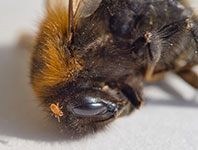Native bees and European honey bees play an important role in our natural ecosystem, pollinating our flowering fruit, vegetables and flowering plants.
European honey bees can be an unwanted pest when they swarm and land in your garden or a welcome guest when they produce honey for your friends and family.
Honey bees have distinctive yellow and black bodies with black legs and live in large numbers in hives. Although they have similar colouring, honey bees are slightly smaller than European wasps and are less aggressive, usually only sting in self-defence.
Keeping European Bees to Produce Honey
Backyard honey bee keeping is a fascinating and occasionally profitable hobby. A hive or two can be kept in most parts of Victoria, including cities and towns.
In the City of Whitehorse, The Whitehorse Community Local Law 2014 permits residents to keep honey bee hives on their property in accordance with the relevant Apiary Code of Practice.
The following documents are useful for keeping honey bee hives.
Varroa Mite
Varroa mite (Varroa destructor and Varroa jacobsoni) is a parasite of adult honey bees and honey bee brood. It weakens and kills honey bee colonies and can also transmit honey bee viruses. It is considered the greatest threat to Australia's honey and honey bee pollination plant industries. Varroa Mite is a notifiable pest and bee keepers need to contact the Agriculture Victoria if they detect an infestation in their hive.
There is a current Varroa Mite infestation in New South Wales and the State of Victoria has been declared a Control Area which means a permit is required to bring bee hives or bee products into Victoria from NSW.
Honey Bee Swarms
Signs of Honey Bee Swarms
Honey bee swarms can occur in spring and early summer when a group of honey bees split from a hive in search of a new home. Honey bee swarming is an essential stage in their natural life cycle and usually occurs during spring and summer (September to December).
Slow moving honey bee swarms can form a vertical football shaped cluster on a fence posts, tree branch, bench or in a letterbox or compost bin, while the scout bees fly out to find a permanent home. Honey bee swarms are generally not aggressive unless disturbed and often stay in an area only one or two days before moving on.
If you see a honey bee swarm:
- Do not disturb the swarm – this can aggravate the bees and makes it more difficult for removal
- Keep children and animals well away from the swarm
- Wear footwear to protect your feet in case bees have settled on the ground.
Controlling Honey Bee Swarms
| Location | Responsibility | Contact/Action |
|---|---|---|
| Your Property | The resident |
Report the swarm to: Swarm Patrol. Swarm Patrol will attempt to match the swarm to a local bee keeper for collection. Some beekeepers will do this for free. The sooner you report a swarm the better before it enters into walls or other cavities, becoming difficult to remove and potentially costing you more money. Or contact: Victorian Apiarists' Association
|
| Your Neighbour’s Property | Your neighbour |
Speak to the property owner about your observations. Direct them to this page for information. If the problem continues, contact Council |
| Council Property | Council | Contact Council |
| Power Pole | United Energy | Notify United Energy |
| Telecommunications Pit | The telecommunications company that owns the pit | Report the nest to the faults line of the telecommunications company |
Honey Bee Stings
Seek medical advice if a honey bee sting inflames areas of skin around the site of the sting or swelling or redness appear to spread or the area appears to be infected.
If the stung person suffers an anaphylactic reaction, immediately dial 000.
More information about insect bites and stings:








